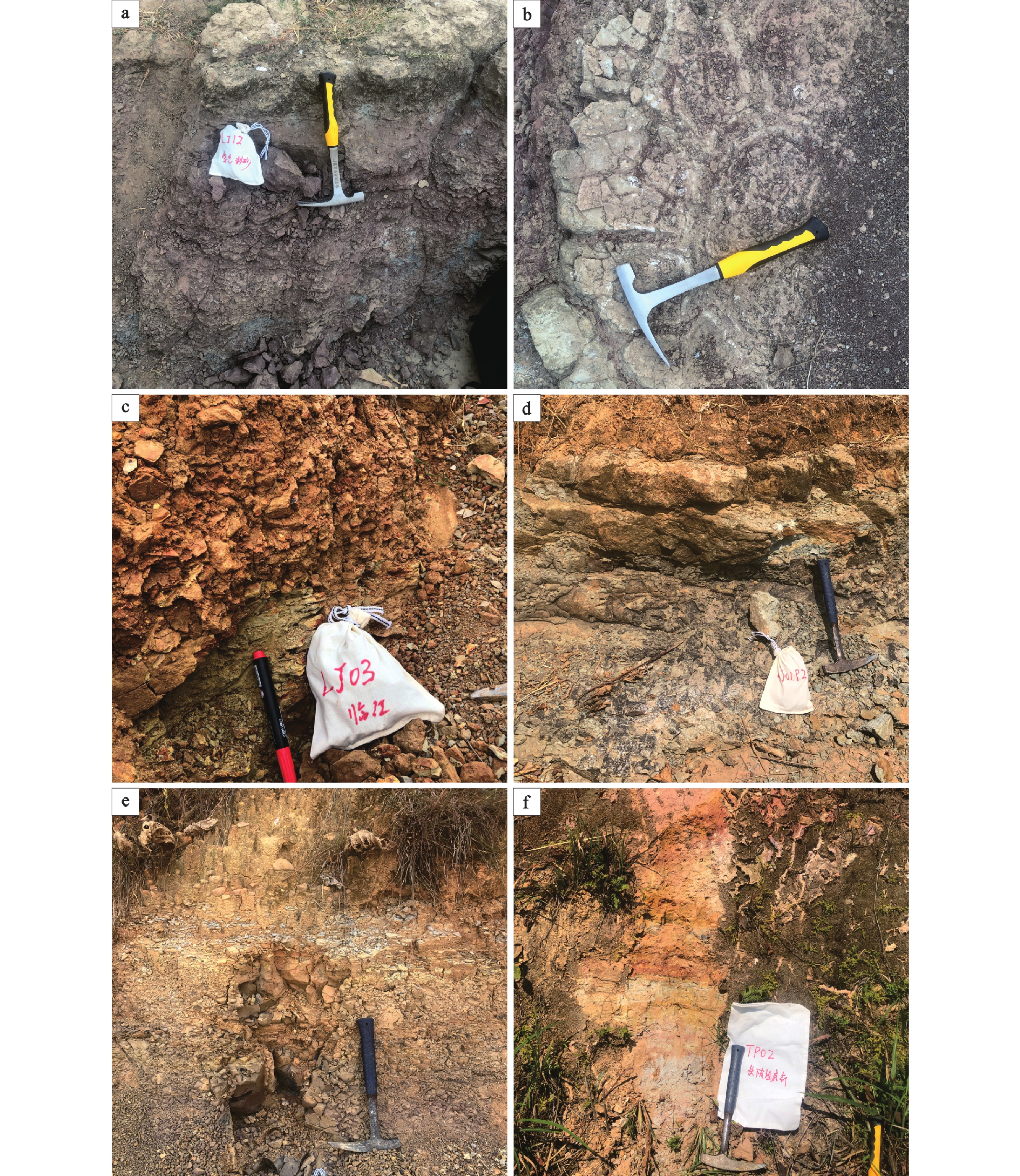The Characteristics of Clay Minerals of the Eocene-Miocene Continental Strata in the Zhangshu-Guangchang Region, Jiangxi Province and its Paleoclimatic Significance
-
摘要:
针对华南地区新生代气候敏感沉积物的研究,表明该时期古气候总体上经历了由干旱到湿润的转变,但是关于这一气候转变的具体演化过程缺乏更为详细的刻画。本文以华南东部江西省樟树-广昌地区始新世-中新世陆相地层为研究对象,系统开展全岩矿物含量和黏土矿物X射线衍射(XRD)分析。结果表明黏土矿物主要由伊利石和伊蒙混层组成,伊利石相对含量为7% ~ 63%,高岭石相对含量为0% ~ 93%,绿泥石相对含量为0% ~ 17%,伊蒙混层相对含量为0% ~ 63.2%。根据黏土矿物的组合、相对含量变化,结合前人研究成果,认为该地区始新世-中新世期间古气候经历了从相对干旱到半干旱半湿润气候转变,干湿变化的时间发生在中新世早期。这一认识为华南地区的古气候演变研究提供了重要参考。
Abstract:The study of climate-sensitive sediments from the Cenozoic in the South China Block indicates that the paleoclimate during this period generally experienced a transition from arid to humid conditions. However, there is a lack of detailed characterization regarding the specific evolutionary process of this climate transition. This paper focuses on the Eocene to Miocene continental strata in the Zhangshu-Guangchang area of Jiangxi Province in eastern South China, systematically conducting whole-rock mineral content and clay mineral X-ray diffraction (XRD) analyses. The results show that the clay minerals are primarily composed of illite and illite-smectite mixed layers, with relative contents of illite ranging from 7% to 63%, kaolinite from 0% to 93%, chlorite from 0% to 17%, and illite-smectite mixed layers from 0% to 63.2%. According to the combinations and relative abundance changes of clay minerals, along with previous research findings, it is suggested that the paleoclimate in this region change from relatively arid to semi-arid and semi-humid conditions during the Eocene to Miocene in the early Miocene. This understanding provides important references for the study of paleoclimate evolution in the South China Block.
-

-
表 1 樟树-广昌地区始新世-中新世地层全岩矿物含量统计表(%)
Table 1. Statistical table of the whole rock mineral content for the Eocene-Miocene strata in the Zhangshu-Guangchang area (%)
样品编号 地层 方沸石 石英 钾长石 斜长石 菱铁矿 角闪石 针铁矿 方解石 黄铁矿 赤铁矿 黏土矿物总量 TP01 头陂组 / 19.1 0 8.4 3.3 1.4 0 0 1.1 0 66.7 TP02 头陂组 / 42.3 0 1.4 1.1 0 0 0 0 0 55.2 LJ01 临江组 / 74.3 2.5 12.2 0.5 0 0 0 0 0 10.5 LJ01P2 临江组 / 41.5 3.9 4.5 0.7 0 0 11 0.7 0 37.7 LJ02 临江组 / 25.1 1.4 1.7 0.8 0 0 0 0 0 71.1 LJ03 临江组 / 32.2 1.3 2 0.7 0 0 0 0 0 63.7 LJ03P2 临江组 / 25.5 0 3.4 2 0 8.7 0 0 0 60.5 LJ05 临江组 / 35.3 3.6 7.1 0.9 0 0 5.5 0 1 46.4 LJ06P1 临江组 / 16.8 1.1 2.8 0.9 0 0 0 0 1.8 76.7 LJ06P3 临江组 / 13 1.3 2.4 1.1 0 0 0 0 1.9 80.2 LJ08 新余组 3 18.6 0.8 5.1 0.9 0 0 30.7 0 0 40.9 LJ12 新余组 / 46.6 1.3 12.2 0.7 0 0 13.7 0.6 0 24.9 平均值 32.53 1.43 5.27 1.13 0.12 0.73 5.08 0.2 0.4 52.88 表 2 樟树-广昌地区始新世-中新世地层黏土矿物相对含量统计表
Table 2. Statistical table of relative content of clay minerals for the Eocene-Miocene strata in the Zhangshu-Guangchang area
样品编号 地层 蒙脱石 伊利石 高岭石 绿泥石 伊蒙混层 绿蒙混层 % % % % % 混层比 % 混层比 TP01 头陂组 / 28 12 8 52.5 49 / / TP02 头陂组 / 7 93 0 0.0 / / / LJ01 临江组 / 36 4 0 60.1 73 / / LJ01P2 临江组 / 41 2 8 48.0 48 / / LJ02 临江组 / 54 0 1 44.7 64 / / LJ03 临江组 / 63 0 1 35.5 56 / / LJ03P2 临江组 / 61 39 0 0.0 / / / LJ05 临江组 / 30 3 3 63.2 55 / / LJ06P1 临江组 / 56 2 4 38.5 61 / / LJ06P3 临江组 / 48 / / 52.4 54 / / LJ08 新余组 / 55 0 7 37.5 47 / / LJ12 新余组 / 45 4 17 34.0 69 / / -
[1] 鲍 晶,叶程程,栗兵帅.2022.粘土矿物的提取、鉴定及其古气候意义——以柴达木盆地怀头他拉剖面为例[J]. 干旱区地理,45(3):814-825.
[2] Boucot A J,陈 旭,Scotese C R,Morley R J. 2009. 显生宙全球古气候重建[J]. 北京:科学出版社.
[3] 陈 涛,王 欢,张祖青,王河锦.2003.粘土矿物对古气候指示作用浅析[J]. 岩石矿物学杂志,(4):416-420. doi: 10.3969/j.issn.1000-6524.2003.04.022
[4] 董红梅,宋友桂.2009.黏土矿物在古环境重建中的应用[J]. 海洋地质与第四纪地质,29(6):119-130.
[5] 江西省地质矿产局. 1984. 江西省区域地质志[M]. 北京:地质出版社.
[6] 江新胜,崔晓庄,伍 皓,熊国庆,卓皆文,陆俊泽,江卓斐.2012.青藏高原东缘古近纪沙漠及其对季风起源的启示[J]. 沉积与特提斯地质,32(3):54-63. doi: 10.3969/j.issn.1009-3850.2012.03.005
[7] 李增学,周 静,吕大炜,王东东,刘海燕,杨其栋.2013.琼东南盆地崖城组煤系空间展布特征[J]. 山东科技大学学报(自然科学版),32(2):1-8.
[8] 林 旭,吴中海,董延钰,谢远云,刘海金,李兆宁.2024.新生代亚洲季风的演化过程[J]. 地质力学学报,30(4):673-690. doi: 10.12090/j.issn.1006-6616.2023093
[9] 刘成林,余小灿,赵艳军,王九一,王立成,徐海明,李 坚,王春连.2016.华南陆块液体钾、锂资源的区域成矿背景与成矿作用初探[J]. 矿床地质,35(6):1119-1143.
[10] 刘东生,郑绵平,郭正堂.1998.亚洲季风系统的起源和发展及其与两极冰盖和区域构造运动的时代耦合性[J]. 第四纪研究,(3):194-204. doi: 10.3321/j.issn:1001-7410.1998.03.002
[11] 孙存礼.1981.江西晚第三纪地层的发现[J]. 地质论评,(3):256-259. doi: 10.3321/j.issn:0371-5736.1981.03.012
[12] 孙庆峰,陈发虎,Colin C,张家武.2011.粘土矿物在气候环境变化研究中的应用进展[J]. 矿物学报,31(1):146-152.
[13] 汤艳杰,贾建业,谢先德.2002.粘土矿物的环境意义[J]. 地学前缘,9(2):337-344. doi: 10.3321/j.issn:1005-2321.2002.02.011
[14] 田 馨,向 芳,罗 来,宋见春.2009.陆相特殊沉积的研究方法及气候意义[J]. 地学前缘,16(5):71-78. doi: 10.3321/j.issn:1005-2321.2009.05.007
[15] 童国榜,贾秀梅,郑绵平,袁鹤然,刘俊英,王伟铭.2002.江汉盆地始新世中、晚期气候变化周期性的孢粉学证据[J]. 地球学报,23(2):159-164. doi: 10.3321/j.issn:1006-3021.2002.02.011
[16] 王 钦,马 丽,周仕林.2022.江西古近纪岩相古地理及其矿产资源概况[J]. 四川地质学报,42(1):24-29. doi: 10.3969/j.issn.1006-0995.2022.01.005
[17] 王成善,胡修棉,2005. 白垩纪世界与大洋红层[J]. 地学前缘,12(2):11-21.
[18] 吴乃琴. 1989. 江西清江盆地临江组非海相腹足类化石及时代讨论[J]. 古生物学报,28(6):751-765+831-832.
[19] 向 芳,宋见春,罗 来,田 馨.2009.白垩纪早期陆相特殊沉积的分布特征及气候意义[J]. 地学前缘,16(5):48-62. doi: 10.3321/j.issn:1005-2321.2009.05.005
[20] 徐先兵.2022.南岭地区白垩纪至古近纪陆相盆地及其对气候变化与构造域转换的制约[J]. 华南地质,38(4):569-582. doi: 10.3969/j.issn.2097-0013.2022.04.001
[21] 杨卫东,陈南生,倪师军,南君亚,吴明清,蒋九余,叶健骝,奉新湘,冉 勇.1993.白垩纪红层碳酸盐岩和恐龙蛋壳碳氧同位素组成及环境意义[J]. 科学通报,38(23):2161-2161.
[22] 叶婷婷,颜照坤,张代柱,邵崇建,颜晨雨,赵文武,龚楚云,王锦程.2023a.陆相气候敏感沉积物在深时古气候演变研究中的应用——以我国中东部白垩纪古气候研究为例[J]. 江西科学,41(2):317-325.
[23] 叶婷婷. 2023b. 华南地区新生代陆相气候敏感沉积物时空分布特征与古气候演化规律[D]. 东华理工大学硕士学位论文.
[24] Biscaye P E. 1965. Mineralogy and Sedimentation of Recent Deep-Sea Clay in the Atlantic Ocean and Adjacent Seas and Oceans[J]. Geological Society of American Bulletin, 76(7): 803-800. doi: 10.1130/0016-7606(1965)76[803:MASORD]2.0.CO;2
[25] Herman A B, Spicer R A, Aleksandrova G N, Yang J, Kodrul T M, Maslova N P, Spicer T E V, Chen G, Jin J. 2017. Eocene-early Oligocene climate and vegetation change in southern China: Evidence from the Maoming Basin[J]. Palaeogeography, Palaeoclimatology, Palaeoecology, 479: 126-137.
[26] Hong H L, Li Z H, Xue H J, Zhu Y H, Zhang K X, Xiang S Y. 2007. Oligocene clay mineralogy of the Linxia Basin: Evidence of Paleoclimatic evolution subsequent to the initial-stage uplift of the Tibetan Plateau[J]. Clays and Clay Minerals, 55(5): 491-503. doi: 10.1346/CCMN.2007.0550504
[27] Xie Y L, Wu F L, Fang X M, Song J Z, Niu Z C. 2022. Late Eocene onset of the East Asian Monsoon in the Qingjiang Basin of Central Jiangxi Province (Southeast China) revealed by a major vegetation transition from desert to forest[J]. Palaeogeography, Palaeoclimatology, Palaeoecology, 602: 111179.
-




 下载:
下载:



